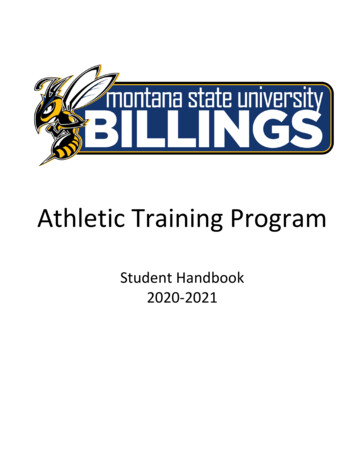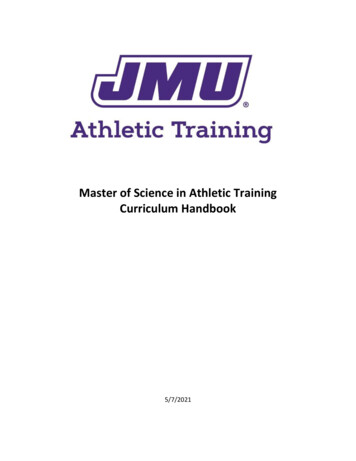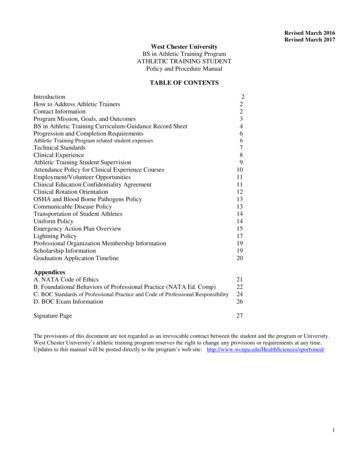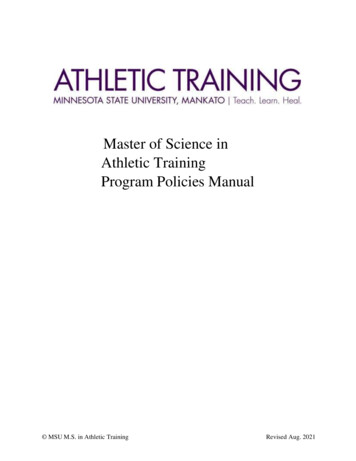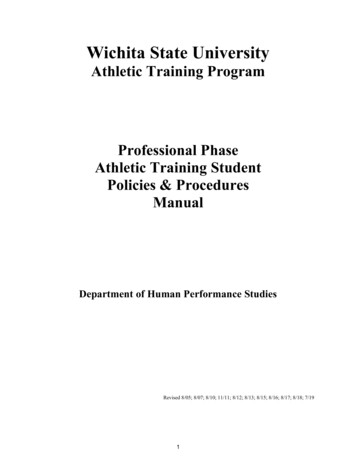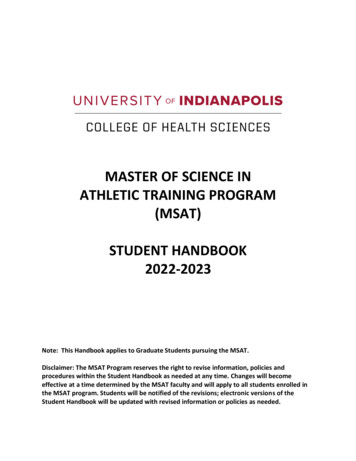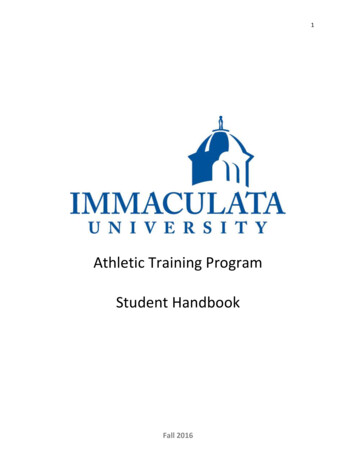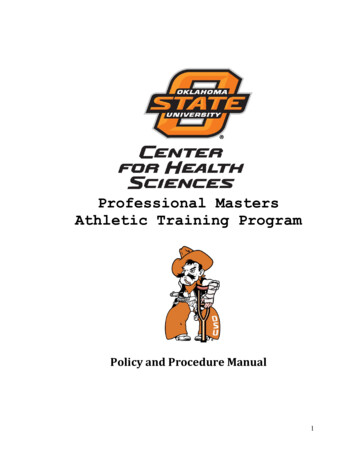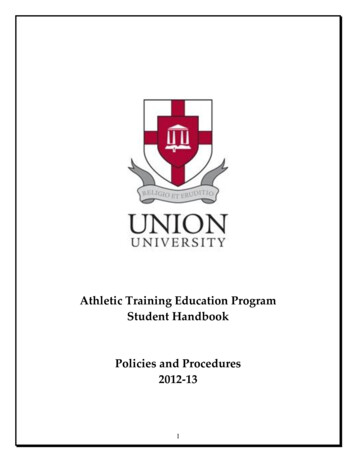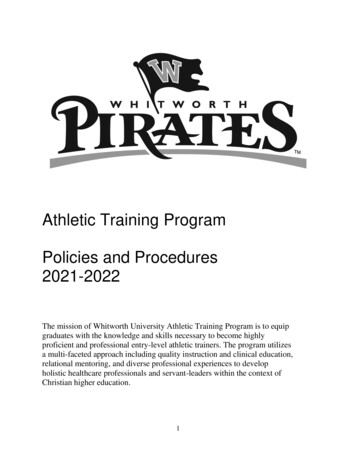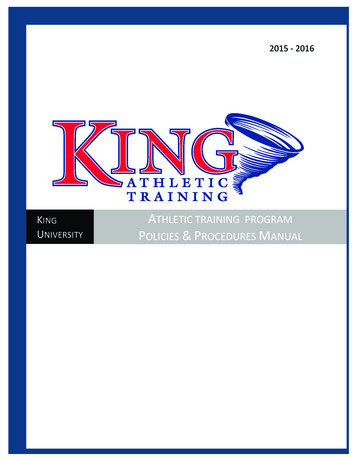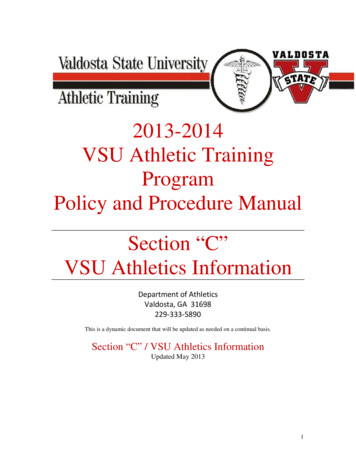
Transcription
2013-2014VSU Athletic TrainingProgramPolicy and Procedure ManualSection “C”VSU Athletics InformationDepartment of AthleticsValdosta, GA 31698229-333-5890This is a dynamic document that will be updated as needed on a continual basis.Section “C” / VSU Athletics InformationUpdated May 20131
ATHLETIC TRAINING POLICIES AND PROCEDURESMAY 2013Basic Athletic Training Rules and RegulationsStudent Dress and Appearance CodeTravel ProceduresUse of SuppliesVisiting TeamsGame ConductPractice CoverageGeneral Public and MediaAthletic Training Communication: Chain of CommandProcedure for Record KeepingMedication UseEmergency Action PlansLightning Safety PolicyLightning Safety Compliance StatementConcussion Management Guidelines245555666912143339402
BASIC ATHLETIC TRAINING STAFF RULES AND REGULATIONSThe following rules and regulations are important for a properly functioning athletictraining program. We are professionals working in an allied health facility, and these guidelinesserve as a blueprint to ensure a professional atmosphere and medical facility.ATHLETIC TRAINING ROOM RULESAthletic Training Staff1. The athletic training room is a medical facility and should be treated as such.2. The athletic training room must be kept spotless to maintain a clean, sanitaryworking environment. It is the responsibility of every athletic trainer and athletictraining student to clean and maintain all equipment in the athletic training room.a. Opening Proceduresi. Arrive prior to scheduled opening timeii. Pull the files of the athletes that you know you will be treatingiii. Get treatment iceiv. Set taping supplies out on the counterv. Mix a 1:10 bleach/water solution for cooler or water bottle cleaningvi. Wipe down tables with commercial cleaner after each patient whenpossiblevii. Check the water in the hydrocollatorviii. Fold towels and put them awayb. Closing proceduresi. Wipe down table and counter tops with disinfectant followingdirections for length of time for surface contact. It is expected thatyou move items to clean and not clean around them.ii. Clean coolers and place them in storageiii. Bring kit in and restockiv. Take out trashv. Disinfect whirlpool and knee tankvi. Complete any paperwork (SOAP, injury reports, treatment log)vii. Vacuum, sweep, and mop the floorviii. Regular communication with coaches and strength coaches.ix. Put towels in the wash.x. Make sure the athletic training room doors are locked.c. Weekly dutiesi. Clean the hydrocollatorii. Clean rehab and exercise equipment; wipe down cuff weights, medballs, etc.iii. Clean the exterior of the ice machine (wipe down the interior if yousee any mildew)iv. Practice emergency skills.v. Restock supplies3
e. Semester dutiesi. PE and FB athletic training rooms ask custodian to shampoocarpet. BSB/FB scrub the floorii. Scrub out all coolers, clean spouts3. Allow no one to be in the athletic training room without personal supervision.4. Nothing will be taken from the athletic training room by an ATS without permissionfrom a staff member.5. No tobacco use will be tolerated in the athletic training room.6. Do not allow any horseplay, visiting, loitering, swearing, or shouting. The athletictraining room is not a lounge.7. The athletic training room phone should be answered professionally in the followingmanner:i. "Athletic Training Room, (your name) speaking."ii. Phone messages should be taken accurately with your signature,date, and time of call.8. No one may use the phone for personal reasons without permission.9. Do not leave the athletic training room open if you will be away for any length oftime.10. Do not allow any towels to be taken from the athletic training room.11. No cleats or spikes are permitted in the athletic training room.12. Make sure athletes shower before receiving treatments after practice.13. The computers in the athletic training rooms are not for personal use (ie.checkingemail, surfing the net, downloading, etc.). The computer is for staff use, recordkeeping, and internet logging for educational hours. It should be re-started onFridays to update the anti-virus software.14. Cell phones must be in the non-ring mode. Non-emergent calls are not permitted.Athletic Training Students are not permitted to be using or checking their cellphones/texting during their clinical rotations.15. No hats are permitted in the athletic training facility.16. No food or drink is permitted in the athletic training facility.Student Athlete1. The athletic training room is a medical facility and should be treated as such.2. Nothing will be taken from the athletic training room by a student athlete withoutpermission from a staff member.3. No tobacco use will be tolerated in the athletic training room.4. Horseplay, visiting, loitering, swearing, or shouting, etc. is prohibited. The athletictraining room is not a lounge.5. No one may use the phone for personal reasons without permission.6. No cleats or spikes are permitted in the athletic training room.7. You must shower before receiving treatment following practice and/or games.8. Cell phones must be in the non-ring mode. Non-emergent calls are not permitted.Some facilities prohibit the use of cell phones.9. No hats are permitted in the athletic training facility.10. No food or drink is permitted in the athletic training facility.11. Report injuries as soon as they occur.4
12. The policy for personal items left in an athletic training facility is, “If you leave it wewill freeze it.”STUDENT DRESS AND APPEARANCE CODEAn athletic training student shall act and dress like an allied health professional in theathletic training room, at practice, at games, and while traveling. It is the responsibility of eachstudent to keep his/her uniform neat and clean. A professional, neat, and clean personalappearance while on duty is an important factor in gaining respect of athletes, coaches, faculty,and the general public.DRESS AND APPEARANCE CODEDaily Operations1. Students are expected to present a professional appearance and attitude at all times.2. You must wear issued VSU Athletic Training clothing.3. Shirts must be tucked into the waistline of the shorts or pants at all times. (Noexceptions)4. Inclement weather: check with supervising ATC5. NO jeans sweat pants, yoga pants. Wind suit pants or khaki pants are acceptable duringcooler weather.6. Maintain appropriate hair length and professional looking hairstyle that is wellgroomed. Males: side burns above the middle of the ear, and you must be clean shavendaily. Females with shoulder length hair must have hair pulled back, and hair beyondshoulder length must be in a ponytail. Pre wrap is not an appropriate headband.7. NO facial piercing for male. Female piercing is limited to ears that look professional.Female earrings must be modest for safety purposes (no large hoops or danglingearrings). No visible body piercing is permitted.8. It is not permissible to wear program clothing outside of your clinical experience.9. Fingers must be properly manicured per OSHA regulations. No nail polish or fake nailsare permitted. Nails much be trimmed so they do not protrude beyond finger.10. No visible tattoos. Tattoos must be covered before arriving in the ATR with student’spersonal supplies, not supplies from the ATR. AT may require long pants or long sleevesbe worn if they cannot be covered appropriately otherwise.11. Athletic shoes must be worn at all times within the athletic training setting. No sandals,flip-flops, heel less or high heel shoes will be allowed.12. If you wear any unacceptable clothing, you will be sent home for the day including:a. Hats with non-VSU logob. Pants worn too low (left to discretion of supervising ATC)13. Athletic Training Students must wear a watch with seconds reading.Game Operations1. Khaki shorts or pants. The length of shorts will be considered appropriate when theshorts extend beyond the fingers with your arms resting at your side, and not goingbelow the knee. A belt must be worn and no underwear may be showing.5
2. Dress appropriately according to sport (i.e. basketball, volleyball). Check with yoursupervising ATC regarding appropriate dress.3. Inclement weather: check with supervising ATC4. Clothing must be modest. All clothing must cover the belly and buttocks. Shorts mustbe of at least mid-thigh length, adhering to the length requirements stated above.Shorts must have a hem (no cutoff jeans or slacks). Clothing with holes in revealingareas and tank tops will not be allowed. Clothes must not be too tight. “tightness” willbe determined by supervising ATCTRAVEL PROCEDURESAn athletic training student can travel only if invited by the supervising ATC. You mayrefer to the travel policy in the clinical portion of the manual. Each clinical supervisor mayestablish specific travel procedures for their site.While traveling you are on the same schedule as the athletes, thus you are expected tofollow the schedule and be on time and ready to go. Each athletic training student isresponsible for packing the necessary equipment and supplies for away contests. Make sureyou have everything (going and coming) and be on time!!!USE OF SUPPLIESThe supplies in the athletic training room are for the athletes of Valdosta StateUniversity. It is the responsibility of the entire athletic training room staff to make sure suppliesare not taken from the athletic training room without permission. If supply of a particular itemis low notify a staff athletic trainer. Keep storage rooms neat and replenish kits from storagesupplies (not from supplies in the athletic training room).VISITING TEAMSAthletic training students will introduce themselves to visiting athletic trainers, and findout the name of the ATC covering the event and where they will be during competition. Youshould offer your assistance and explain what services will be provided. Be sure to explain theemergency plan, location of nearest athletic training room for ice, water, and modalities tovisiting athletic trainers. This is very important and is a positive reflection on our program. Beprofessional and show good sportsmanship. Be sure to follow the conference guidelines as ahost team.GAME CONDUCTBe on time and in uniform. Arrive early enough to prepare necessary equipment (kit,water, ice, emergency equipment, etc.). Introduce yourself to the visiting coach and/or athletictrainer and offer available services. Do not make critical comments in regard to an athlete'sperformance or an official's call. Keep your eyes on the action to witness mechanism ofinjuries and to protect yourself. Athletic Training Students are not permitted to be using orchecking their cell phones/texting during their clinical rotations.6
PRACTICE COVERAGEPractice coverage is an integral part of the athletic trainer's function. It may seem thatyou are performing some mindless or unimportant task like providing water, but no task ismeaningless. View each job as a learning experience. Choose an advantageous position on thefield (close to the action but not in the way). Always keep your eyes on the action to witnessmechanisms of injuries. You are looking for mechanisms of injury. Be alert and attentive. Donot stand in a group. The proper equipment (kit, ice, water, emergency equipment, etc.) shouldbe in the proper location and in good working order. Carry necessary supplies (scissors, tape,gauze pads, etc.) with you during practice. Injuries can occur during the first and/or final minuteof practice, so always be prepared. Athletic Training Students are not permitted to be using orchecking their cell phones/texting during their clinical rotations. Some discussion amongathletic training students is permissible as long as it is not interfering with practice or yourclinical experience. If these discussions become a problem, you will be asked to leave practiceand your clinical coordinators will be notified.GENERAL PUBLIC/MEDIAOn occasion you will be confronted with questions as to the health of an athlete. Thisinformation is confidential, protected by federal law (HIPAA) and is not to be discussed outsideof the athletic training room. All questions pertaining to athletes should be referred to a staffcertified athletic trainer.ATHLETIC TRAINING COMMUNICATIONCHAIN OF COMMANDIn order to establish effective communication, a chain of command must be established.It is important that all members of the program follow this process. It is as follows:1. Medical Director and/or Team Physician2. Staff Certified Athletic Trainer3. Graduate Assistant Athletic Trainers4. Coaches5. Athletic training students with the most experienceFailure to follow this chain of command can result in a breakdown of the total program.COMMUNICATION WITH OTHER STAFF AND PERSONNELTeam PhysicianAthletic training students will have the opportunity to observe, listen, and work witheither the team physician, medical director, or other medical specialists associated with theprogram. Watching and listening is a great way to learn. Be tactful with physicians and officestaff, look and act professional, and be assertive in observing.Athletic training students are not in a position to refer athletes to the team physician,unless it is an emergency. Consult with a full time staff member concerning whether an athleteshould be seen by a physician. If you are called upon to report with an athlete to the doctor, besure you give detailed information and follow their orders immediately and efficiently.7
The team physician will make the final decision concerning the participation or nonparticipation of an injured athlete. This does not mean he will make all decisions. In theabsence of the team physician the designated certified athletic trainer will make the finaldecision.Staff Athletic TrainersThe staff certified athletic trainers are your supervisors and have full responsibility forthe athletic training program. They are directly responsible for you and your actions, thus youshould follow their directions at all times. Feel free to discuss anything with them at any time.Graduate Assistant Athletic TrainersGraduate Assistant Athletic Trainers are considered to be staff. As a student it is yourresponsibility to interact and communicate with the graduate assistants in a professionalmanner. The graduate assistants are working under the guidance of the staff athletic trainers.You are accountable for following their directions.Graduate Assistant Athletic Trainers are required to adhere to the policies andprocedures for the university, athletic department, and athletic training program. Graduatestudents are not permitted to date, fraternize, etc. with student athletes. Failure to adhere tothese policies and procedures will result in dismissal.CoachesAn athletic trainer must make decisions that many times a coach does not like.Therefore, respect and trust may well be two intangible assets in developing a relationship witha coach. While you are primarily working under the direct supervision of certified athletictrainers, you are also working with coaches and athletic department administrators. Respect,courtesy, and cooperation should characterize your relationship with all department personnel.You are not responsible for "coaching", "second guessing", or "cheerleading". This type ofattitude will quickly lose the respect of coaches and athletes alike. Direct medical responsibilityfor athletes comes under the team physicians and certified athletic trainers while athletes areprimarily responsible to their coaches. It is imperative that a good athletic trainer-coachrelationship is established on the team for which you are responsible. This involves a consistentcommunication process, both written and verbal on the daily health status of the athletes.Remember, discuss but never argue with a coach. If you have a conflict with a coach it shouldbe reported to a staff athletic trainer. The staff athletic trainer will assist you in effectivelycommunicating with the coaching staff.Many coaches rely on athletic trainers in relaying their perception of team moral andattitude. A good rule of thumb is the discussion of non-medical issues be done only when askedby a coach. Observing your supervising certified athletic trainer in his/her interaction with acoach is an excellent learning opportunity. You may also have the opportunity in interactingdaily with coaches, take advantage and refine this skill. It is an essential tool for athletictrainers.Coaches, because they are university employees, are above athletic training students inthe chain of command. If teams are traveling without a VSU certified athletic trainer, coaches8
will consult with the host certified athletic trainer on decisions of return to play for injuredathletes.Athletic Training StudentServicing and caring for a large number of athletes takes a well-coordinated and efficient efforton everyone's part. All members of the athletic training staff are dependent upon each other. Itis expected there will be nothing less than excellent rapport among the athletic trainingstudents. Petty arguments, misuse of authority, or any negative attitudes not conducive tolearning and productivity will not be tolerated. Upperclassmen should take it upon themselvesto instruct younger students on a daily basis. Inexperienced students should seek advice fromexperienced students and freely accept constructive criticism. Remember, the greatest tool forlearning is experience, so share it.Student AthleteEarning the respect of the athlete is an important goal to reach and is in turn very gratifying.Treat all athletes with integrity, respect, and courtesy. Combine friendliness withprofessionalism. Respect can be gained most readily by exhibiting competence. Never guess orpretend to know something that you do not. Show concern, but do not overprotect the athlete.You must draw a line between providing competent and friendly care, and fraternization. Intime you will gradually learn the attitudes, temperaments, and peculiarities of individualathletes; use this insight to foster your professional relationship with them. We want to helpthe athlete pursue an injury-free career. For this to happen all athletes are to adhere to therules and regulations pertaining to them in the athletic training room. Violations of these rulesare to be handled by the individual staff certified athletic trainer in a sensible and courteous butfirm manner. Guidelines for dealing with athletes:1. Gain respect through competence.2. Do not let the athletes dictate to you what is to be done. Base your clinicaldecisions on what you have learned in class or from the ACI, not what the athlete asks.Do not discuss an athlete's injury with anyone who is not a member of the athletictraining or coaching staff. This pertains especially to other athletes.4. Don't become an athlete's "buddy" and bend rules for him/her orprovide special privileges.5. Do not cover up for an athlete.6. Be careful when talking about an injury. In some cases the more anathlete knows the more he /she worries. Let the team physician orcertified athletic trainers estimate how long an athlete will be out due toinjury or illness.7. Treat all athletes without bias and free from discrimination.8. Hold athletes accountable to athletic training rules and team rules.9. Relationship guidelines with student-athletes is addressed in the clinicalsection of the manual.EQUIPMENT PERSONNELThe relationship with equipment personnel should be a close working nature. We willhelp them during travel, practice, and game set up when necessary. It is vitally important toestablish a good working relationship with the equipment personnel and managers. Make sureto properly check out equipment or other materials with the appropriate person.9
PROCEDURE FOR FILING AND RECORD KEEPINGRecord keeping is one of the most important duties of an athletic trainer. Recordkeeping serves three purposes: 1) accountability, 2) providing data for research, and 3)providing us with medical histories of our athletes. To achieve these three purposes an athletictrainer must always record:A. Injuries (time loss or restricted activity)B. Treatment of injuriesC. Medication that is administeredD. Rehabilitation of injuriesE. Special reports (i.e. x-ray, lab work)F. Coaches reportsThese records as well as a medical history and physical examination are always kept in anathlete's personal file. It is the responsibility of the certified athletic trainers that these recordsare neat, accurate, and updated. The filing system in each athletic training room is to beuniform and organized according to the sample file. The following are guidelines for each areaof record keeping.PHYSICAL EXAMINATION AND MEDICAL HISTORYPhysicals will be given prior to the beginning of the season for each sport. New athletesat VSU will go through a comprehensive medical history and physical examination. Returningathletes go through a follow up medical history and physical examination. These are to beseparated by year and organized neatly in the folder for easy access.TREATMENT LOG - SPORTSWAREEvery treatment received by an athlete must be entered into the Sportsware treatmentdatabase. This can prove to be difficult during peak training room hours, but everyone must besure to record all treatments. By the end of each day all treatments must be recordedINDIVIDUAL INJURY REPORTS- SPORTSWARE1. Enter injury into the individual injury report database. Make sure to completely fill outthe injury report including: background information and narrative evaluation notes(HIPLSNF in the notes section).2. Complete individual injury report. Be sure to include signature (or initials) and title (ATSor ATC). If you need help filling out a report be sure to ask a certified staff member. Donot leave records incomplete.3. Update athlete's progress daily with handwritten soap notes.4. Always record date when athlete returns to practice and place in personal filedocumenting evaluation findings upon return to play.10
5. Close the injury out on the database by clicking the “closed” box.SPORTSWAREAll personal, insurance, and medical alerts must be entered into SportsWare.MEDICATION – Enter into SportswareRefer to the Drug Administering policy.REHABILITATION REPORTSAll rehabilitation received by an athlete must be documented on the progress/soap note(or individualized rehab progression) and placed in their respective file.SPECIAL REPORTSOccasionally an athlete will require special testing such as an x-ray or lab work. Theseorders and reports are to be placed in the athlete’s medical file.STUDENT HEALTH REFERRALS1. Call and make an appointment for the student athlete and student must take VSU ID.2. Send white and yellow copy of referral with the student athletic, and keep the pinkcopy as a reminder of the referral.3. Discard the pink copy once the student athlete returns the white copy, and file thewhite copy in the student athlete’s medical file. Remind the athlete that the whitecopy is to be returned the day of the appointment.4. Record any medications on database.5. Do not make an appointment during practice time without consulting the coaches.6. Student Health Center policy: if student misses an appointment once they will bewarned. Following that, they will be charged 15 for any subsequent missedappointments. If they are going to miss their appointment they need to call ASAPand preferable 5 hours before scheduled appointmentAPPOINTMENTS AT THE HUGHSTON CLINIC1. ATC will make appointment with GA for Dr. Jacobson or Kathy Gordon for any otherHughston physician and check if preauthorization is needed.2. The GA will make sure their insurance has been sent to the Hughston Clinic3. The GA will remind the staff of re-checks a week ahead of time, and give them aHughston appointment reminder to give to the athlete4. Give athlete directions and stress importance of being on time.5. Make sure x-ray’s or MRI films are picked up and taken to appointment.6. GA/ATS should obtain the following information during appointment: diagnosis,prognosis, treatment plan, status, any other tests required, set up return appointmentwith GA if necessary, answer any questions of the athlete, then record notes from visitinto athlete’s SOAP note.7. Dictation report must be communicated to respective ATC the day of the appointment.Hard copy must be delivered (fax) to respective ATC that day as well.11
MEDICAL PROCEDURESAll medical procedures must be pre-approved. Make sure reports are sent to thereferring physician.DOCTOR’S NOTES**If you record notes for Dr. Jacobson or Dr. Collins:BE CERTAIN THE COPY IS LEGIBLE.When an athlete is seen by a physician it is important that the following information berecorded in the SOAP section of their file or recorded on the Sportsware Doctor’s referral sheet.DiagnosisPrognosisTreatment PlanPrescriptionReturn date12
Valdosta State UniversityAthletic Training ProgramPolicy and Procedure of Medication UsePurpose: To be consistent with the NCAA policy on the administering of prescription medicationand over-the-counter (OTC) medication.General Guidelines1. OTC medications are to be stored in a locked cabinet in the athletic training rooms withonly certified athletic training staff access to the keys. For OTC’s, one box or containerof the OTC will be available at a time, the rest of the inventory shall be locked in thestorage room.2. OTC’s will be maintained in single-dose packets, complete with information required bythe FDA’s 7-point label guideline.3. Administration of OTC’s, iontophoresis, and phonophoresis will follow establishedprotocols approved by team physicians and/or the Student Health Center.Documentation should take place in the student-athlete’s medical file.4. Distribution of OTC’s and prescription medications is to be recorded in the studentathlete’s medical chart and/or injury reporting software.5. Inventory of OTC’s and prescription medications will take place along with the regularinventory paying particular attention to expiration dates, and reconciliation withordered, distributed, and available.6. Emergency medications should be prescribed to specific patients based on theirparticular condition. Emergency medications will also be kept in stock and followestablished usage protocols approved by the team physician.7. Expired medications will be delivered to the Student Health Center for disposal.8. Follow up should be performed on student athletes requesting OTC’s and/or takingprescription medication for prolonged periods of time.9. A drug dispensing log may be used in each facility then entered into the studentathlete’s medical record.10. OTC’s will be given out as a dosage package when requested by the athlete orprescribed as a form of treatment by the team physician. Unit doses may be13
administered for a 24 hour period if requested by the student athlete, or 48 hours ifover a weekend.11. Student Athletes should be instructed on proper dosing.Kits/Travel1. All emergency and travel kits containing prescription and OTC drugs should be routinelyinspected for drug quality, security and expiration dates; all medication should be removedfrom kit when not in use.2. The amount of medication to be taken when traveling will be determined by the amount ofdays of the trip; usually for weekend trips, practices, or games 12 dosage packets should beenough. Keeping a minimum amount of OTC’s will help to prevent the breakdown of themedication due to exposure to excessive temperature.3. All OTC's and prescription medication should be within the possession of the athletic trainerwhen traveling and not under the bus or plane.4. Teams traveling without an ATC will not have OTC’s in the medical kits.5. International travel will take special consideration.Minors1. OTC’s cannot be administered to minors without the parents signed consent.14
VSU EMERGENCY PLANRevised July 2011Emergency situations and/or life threatening conditions may arise at any time duringathletic events and quick action must be taken in order to provide the athlete with the bestpossible care. Developing and implementing an emergency plan will assure that these situationsare handled appropriately.Valdosta State University has a duty to develop an emergency plan that can beimplemented immediately and provide adequate health care for all sports participants. TheONLY way to effectively respond to an emergency is to be PREPARED. To be adequatelyprepared requires: an emergency plan, proper event coverage, proper training of personnel,maintenance of appropriate medical equipment, utilization of appropriate medical personnel,adequate means of communication, and continuing education in emergency medicine for allpersonnel. Despite pre-participation physical exams, adequate medical coverage, safe practiceand training techniques, and preparation of the sports medicine team injuries and accidents arean inherent part of sports.What conditions are considered to be emergencies?Unconscious athleteSuspected C-spine injuryHemorrhageHeat StrokeShockAbsence of pulseAbsence of breathingDiabetic shock or comaExercise Induced Bronchospasm and/or AsthmaWhat conditions require immediate medical attention?FracturesDislocationsSevere sprainsDental injuriesEye injuriesWhat is the VSU chain of command?Team physician/Medical DirectorStaff ATCGraduate Assistant Athletic TrainerCoachAthletic Training StudentComponents of an Emergency PlanA. emergency personnelB. emergency communicationC. emergency equipmentD. emergency transportation15
VSU EMERGENCY POLICIES AND PROCEDURESEMERGENCY PERSONNEL:The first responder to a VSU athletic emergency situation is usually either an athletic trainingstudent or a certified athletic trainer but could be a coach or team member. The teamphysicians are not present at practices. Certification in CPR, first aid, prevention of diseasetransmission, and review of the emergency plan are required for all athletics personnelassociated with practices, competitions, skills instruct
Athletic Training Students are not permitted to be using or checking their cell phones/texting during their clinical rotations. 15. No hats are permitted in the athletic training facility. 16. No food or drink is permitted in the athletic training facility. Student Athlete . 1. The athletic training room is a medical facility and should be .
